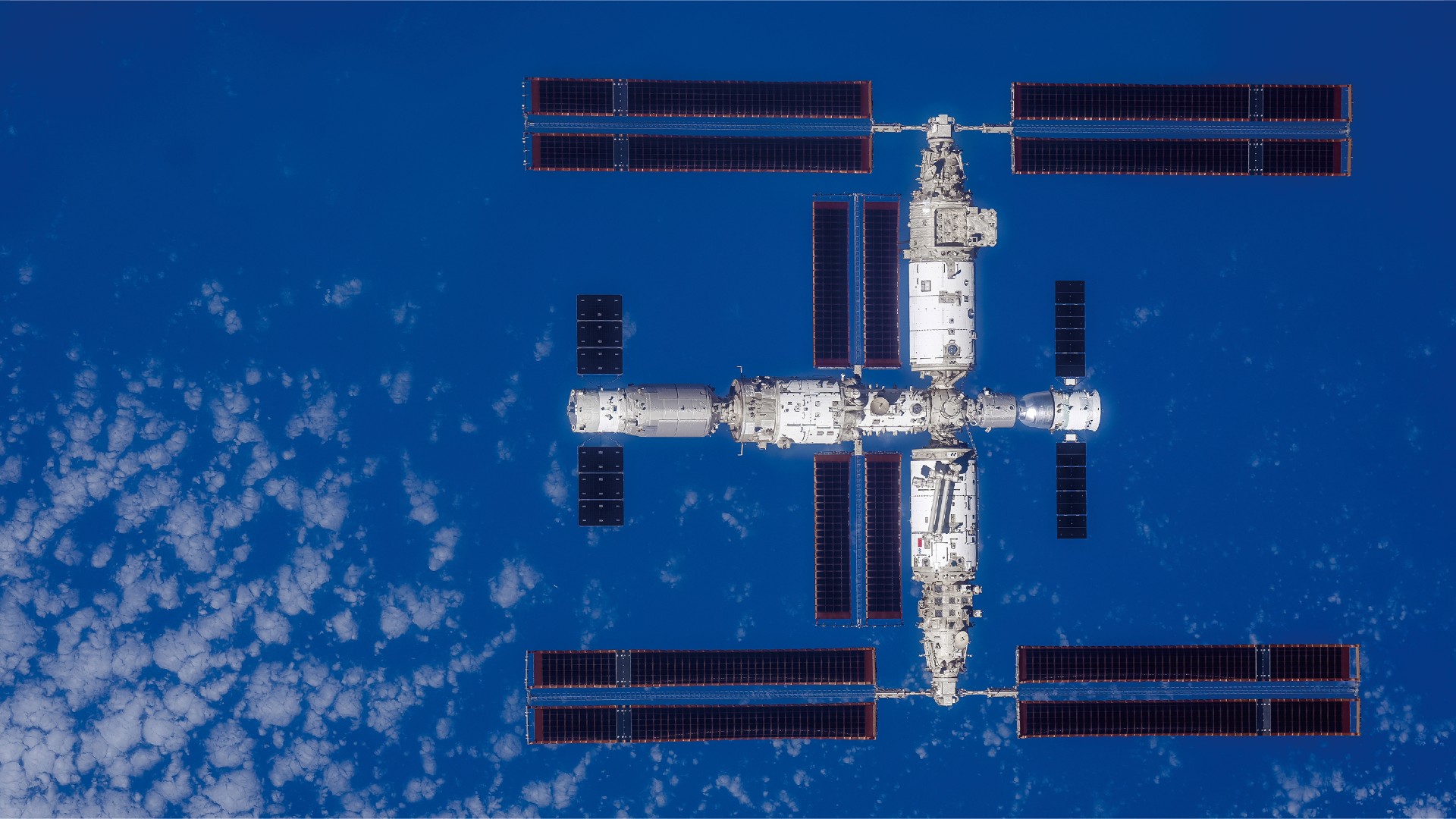How to see and track the Tiangong Chinese space station
The International Space Station isn't the only space station visible from Earth's surface. Astronomers can also observe and image Tiangong, the Chinese space station, but it is a trickier target.

Although it's more challenging to observe than the International Space Station (ISS), the Chinese space station, officially known as Tiangong, can be seen from Earth's surface.
Tiangong, which means "Heavenly Palace" in Mandarin , appears fainter than the ISS because the Chinese space station, along with its solar panel area, is smaller — about 20% the size of the ISS, according to Today in the Sky. However, it is still possible to see Tiangong with the naked eye, you just need to know where and when to look.
Related: China releases 1st images of complete Tiangong space station (photos)
Tiangong orbits Earth at an altitude of around 211 to 280 miles (340 to 450 kilometers) — roughly the same height as the ISS. The orbital speed of China's permanently crewed space station is around 17,200 mph (27,600 km/h).
The first three modules of Tiangong were launched in April 2021, July 2022 and October 2022, respectively. The numberless Tiangong space station is not to be confused with its predecessors, Tiangong-1 and Tiangong-2, launched in 2011 and 2016, respectively. Tiangong will be extended with the addition of the Xuntian space telescope.
When and where to see the Tiangong space station
Most transits of Tiangong over Earth cannot be seen with the naked eye from the surface of our planet, but the station is visible for a few hours after sunset and a few hours before sunrise.
Tiangong doesn't emit its own light, so it can be seen only via scattered light from the sun. During the dead of night, Tiangong is in our planet's shadow and thus too dark to be seen. Therefore, the best time to observe Tiangong is the part of the night when the space station is sunlit.
Breaking space news, the latest updates on rocket launches, skywatching events and more!
When Tiangong is illuminated by the sun and thus visible, the space station appears as a dot of light moving slowly through the sky. Only particularly bright transits of Tiangong are visible to the naked eye, and even the best binoculars are unlikely to resolve the space station in greater detail, however.
So how do you distinguish Tiangong from other objects in the sky? It doesn't look like an airplane because it does not blink, and its slow, continuous movement differs from that of meteorites, which move much faster. That means amateur astronomers are most likely to confuse Tiangong with large, human-made satellites or even the ISS.
Whereas the ISS has an orbital inclination of 51.6 degrees, Tiangong's is 41 to 43 degrees. As a result, Tiangong flies quite far south and thus appears low on the southern horizon. This low orbital inclination also means that Tiangong is not visible from some places on Earth.
For example, from latitudes higher than 60 degrees north, Tiangong will not rise high enough above the horizon to be visible, Space.com previously reported. This region includes a great deal of Alaska and Canada's northern half, as well as countries like Iceland, Norway, Sweden and Finland.
In locations a little farther south — like Edmonton, Alberta; Juneau, Alaska; Dublin, Ireland; and Copenhagen, Denmark — Tiangong will never rise very high over the southern horizon, maintaining an altitude of less than 10 degrees (approximately your clenched fist extended at arm's length).
Between the latitudes of 42.8 degrees south and 42.8 degrees north, Tiangong will occasionally appear to pass high across the sky, occasionally even moving directly overhead.
From regions where the Chinese space station does rise high enough above the horizon to be sighted, Tiangong flies from west to east or from right to left if you're looking toward the south, according to Today in the Sky. When Tiangong passes overhead, the visibility of its transits lasts just a few minutes.
Tiangong predictions
If you're aiming to get more information about when Tiangong will be visible from your specific location, you can access various online resources, such as Heavens Above, Giuseppe Donatiello, an amateur astronomer who's discovered a wealth of celestial objects, told Space.com. "In addition to the times of the various passages, Heavens Above also provides a celestial map with the path of the satellite of interest," he said.
Such information is also very useful for photographing Tiangong "because it allows astrophotographers to know where to frame and shoot Tiangong as it passes through the field of view of the instrument in use," Donatiello added.
Astroviewer is another site you can use to track Tiangong from the ground. The website lists details such as the space station's coordinates, its altitude above Earth and its orbital speed. The website also features a NASA map showing the current position of Tiangong superimposed on Earth, as well as a map delineating the path of the space station's next orbit. This path is divided into blue and red lines, with blue indicating when Tiangong is in Earth's shadow (and thus not visible) and red indicating when the space station is illuminated by the sun.
Photographing Tiangong
Some of the best images of Tiangong and the ISS have been created as astrophotographers have observed the space stations passing in front of the moon or the sun.
"Tiangong is an easy target for wide-field photography," Donatiello said. "We should even be able to take shots and videos with Tiangong using smartphones. However, the best results are those obtained with cameras."
With exposure times of a few seconds, astrophotographers will obtain long stretches of images of Tiangong that represent its trajectory past background stars.
Mounting a camera to a computerized star tracker can also help capture the perfect shot.
Expert Q&A
We asked amateur astronomer and astrophotographer Giuseppe Donatiello a few questions on how to photograph the Tiangong space station.
Have you been able to photograph the Tiangong space station?
I have observed and photographed the Chinese Tiangong space station several times since its first integration.
How easy is this space station to spot compared with the ISS?
Tiangong currently exhibits a brightness among artificial satellites that is less than only the ISS, with [an approximate] magnitude [of] -2.6, versus -3.8 for the latter. [Lower magnitudes are brighter.] This allows us to identify this large satellite easily, and there is a risk of confusing it with the ISS if it were not for the particular orbit it follows in the sky.
Tiangong, in the evening zenith passages, moves with the characteristic trajectory almost from west to east, while the ISS is always markedly inclined with respect to the observer's local meridian.
What tips can you offer to amateur photographers aiming to capture the Tiangong space station?
Good photographs can be obtained in the form of a trail in the sky by placing the camera on a tripod and framing the region it will pass through.
Additional resources
This impressive time lapse shows the Tiangong space station transiting the lunar face, and this gorgeous footage shows Tiangong in stunning detail as it passes the face of the sun. This video from the South China Morning Post shows just one of the experiments underway on Tiangong.
Bibliography
Tiangong flyover, Today in the Sky, [Accessed 11/23/23], [https://www.heute-am-himmel.de/tiangong]
The orbital parameters of the core module assembly, CMS, [Accessed 11/23/23], [https://web.archive.org/web/20210727064415/http://en.cmse.gov.cn/news/202107/t20210722_48418.html]
Observation of Tiangong, AstroViewer, [Accessed 11/23/23], [https://www.astroviewer.net/iss/en/observation-css.php]
Design and Application Prospect of China's Tiangong Space Station, Space: Science & Technology, [2023], [DOI: 10.34133/space.0035]
Tiangong, China's space station, Planetary Society, [Accessed 11/23/23], [https://www.planetary.org/space-missions/chinese-space-station]

Robert Lea is a science journalist in the U.K. whose articles have been published in Physics World, New Scientist, Astronomy Magazine, All About Space, Newsweek and ZME Science. He also writes about science communication for Elsevier and the European Journal of Physics. Rob holds a bachelor of science degree in physics and astronomy from the U.K.’s Open University. Follow him on Twitter @sciencef1rst.



